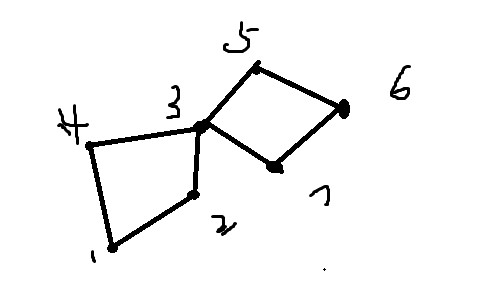欧拉回路心得
对于欧拉回路为什么一定要用栈,偶进行了一下小小的探究(感谢崔学长的数据)。
样例如图所示:

不用栈,直接输出会怎样呢?
void euler(int u){ for(int v=1; v<=n; v++){ if(G[u][v]){ G[u][v]--; G[v][u]--; printf("%d %d\n", u, v); euler(v); } } }
输出结果如下:

一开始输出路径会是1->2->3->4->1,搜完这些,会从3开始继续搜索并输出,3->5->6->7->3。很明显,这是错误的。、
那么用栈呢?
void euler(int u){ for(int v=1; v<=n; v++){ if(G[u][v]){ G[u][v]--; G[v][u]--; euler(v); S.push(node(u, v)); } } }
在main函数里添加:
while(!S.empty()){ node e = S.top(); S.pop(); printf("%d %d\n", e.x, e.y);
}
结果如下:

假设当前走到了3结点,那么下一个应当是4,然后是1,接着的操作是将4->1,3->4入栈,进行完这些操作,会继续搜索3->5->6->7->3,接着把7->3, 6->7, 5->6, 3->5,2->3, 1->2入栈.
依次将这些边弹出会如何?如上图结果显示。
懂了这些,便可将上面代码修改下:
void euler(int u){ for(int v=1; v<=n; v++){ if(G[u][v]){ G[u][v]--; G[v][u]--; euler(v); printf("%d %d\n", v, u) } } }
测试样例:
7 8
1 2
2 3
3 4
4 1
3 5
5 6
6 7
7 3
下面给出完全的用栈保存路径的代码:
#include <iostream> #include <cstdio> #include <cstdlib> #include <cstring> #include <queue> #include <stack> using namespace std; const int maxn = 50+20; int G[maxn][maxn], n; struct node{ int x, y; node(int x, int y):x(x), y(y) {} }; stack<node> S; void euler(int u){ for(int v=1; v<=n; v++){ if(G[u][v]){ G[u][v]--; G[v][u]--; euler(v); S.push(node(u, v)); } } } int main(){ int m; memset(G, 0, sizeof(G)); scanf("%d%d", &n, &m); for(int i=0; i<m; i++){ int u, v; scanf("%d%d", &u, &v); G[u][v] = G[v][u] = 1; } euler(1); while(!S.empty()){ node e = S.top(); S.pop(); printf("%d %d\n", e.x, e.y); } return 0; }


